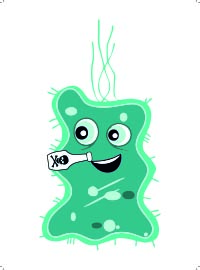Team:Gdansk-UG
From 2013.igem.org
(Prototype team page) |
|||
| Line 1: | Line 1: | ||
| - | |||
| - | |||
| - | |||
| - | |||
| - | |||
| - | |||
| - | |||
| - | |||
| - | |||
| - | |||
| - | |||
| - | |||
| - | |||
| - | |||
| - | |||
| - | |||
| - | |||
| - | |||
| - | |||
{|align="justify" | {|align="justify" | ||
| - | | | + | |We aim to construct bacteria able to detect methanol in ethanol solutions. Our project focuses on using a methanol-dependent promoter and a gene regulated by it – methanol dehydrogenase. We would like to introduce bacteria, which –in presence of methanol – would produce a dye, for instance, GFP. |
| + | The main problem is to find a promoter that is insensible to ethanol. Unfortunately, the most suitable organism – Picha pastoris – has methanol-dependent promoters which are blocked in the presence of ethanol. Therefore, we have found a bacterium which is an obligate methylotroph – Methylobacillus flagellatus. It is unable to utilize 2-carbon compounds due to the absence of enzymes present in TCA cycle. Based on that fact we speculate that the inhibition of the promoter will not take place. | ||
| + | We would like to present two different approaches to our project. Depending on initial results, we will take different measures to reaching our goal. Being restricted by the possibility that the promoter may not act as we would like it to, we thought of another route. | ||
|[[Image:Gdansk-UG_logo.png|200px|right|frame]] | |[[Image:Gdansk-UG_logo.png|200px|right|frame]] | ||
|- | |- | ||
| | | | ||
| - | '' | + | '' |
| + | |||
| + | The first method, based on methanol-dependent promoter is very clear and easy to achieve. Provided that this promoter is insensible to ethanol and that it works well in our final, transformed organism, we only have to measure the efficiency of dye production in different concentrations of alcohols. | ||
| + | The other approach focuses on the reaction catalyzed by methanol dehydrogenase. This enzyme, in the presence of NAD+, is able to alter methanol into formaldehyde. | ||
| + | |||
| + | While detecting the methanol with simple measures is very hard, performing a colorimetric reaction with formaldehyde seems to be quite possible. We are hoping that the enzyme shows higher affinity to methanol than to ethanol, but even if it doesn’t – this method would still be sufficiently precise to detect low concentrations of one-carbon alcohol. | ||
| + | Taking into account that we may decide to follow the second route, we are also gathering information about detecting formaldehyde in purely biological ways. We found a formaldehyde operon but, unfortunately, there is not enough information about it. We are hoping to find either an enzyme, promoter or an operon that would enable us to insert into bacteria a sequence resulting in producing colored substance during bacterial growth in methanol. | ||
| + | '' | ||
|[[Image:Gdansk-UG_team.png|right|frame|Your team picture]] | |[[Image:Gdansk-UG_team.png|right|frame|Your team picture]] | ||
|- | |- | ||
Revision as of 09:30, 10 August 2013
| We aim to construct bacteria able to detect methanol in ethanol solutions. Our project focuses on using a methanol-dependent promoter and a gene regulated by it – methanol dehydrogenase. We would like to introduce bacteria, which –in presence of methanol – would produce a dye, for instance, GFP.
The main problem is to find a promoter that is insensible to ethanol. Unfortunately, the most suitable organism – Picha pastoris – has methanol-dependent promoters which are blocked in the presence of ethanol. Therefore, we have found a bacterium which is an obligate methylotroph – Methylobacillus flagellatus. It is unable to utilize 2-carbon compounds due to the absence of enzymes present in TCA cycle. Based on that fact we speculate that the inhibition of the promoter will not take place. We would like to present two different approaches to our project. Depending on initial results, we will take different measures to reaching our goal. Being restricted by the possibility that the promoter may not act as we would like it to, we thought of another route. | |
|
The first method, based on methanol-dependent promoter is very clear and easy to achieve. Provided that this promoter is insensible to ethanol and that it works well in our final, transformed organism, we only have to measure the efficiency of dye production in different concentrations of alcohols. The other approach focuses on the reaction catalyzed by methanol dehydrogenase. This enzyme, in the presence of NAD+, is able to alter methanol into formaldehyde. While detecting the methanol with simple measures is very hard, performing a colorimetric reaction with formaldehyde seems to be quite possible. We are hoping that the enzyme shows higher affinity to methanol than to ethanol, but even if it doesn’t – this method would still be sufficiently precise to detect low concentrations of one-carbon alcohol. Taking into account that we may decide to follow the second route, we are also gathering information about detecting formaldehyde in purely biological ways. We found a formaldehyde operon but, unfortunately, there is not enough information about it. We are hoping to find either an enzyme, promoter or an operon that would enable us to insert into bacteria a sequence resulting in producing colored substance during bacterial growth in methanol. | |
| Team Gdansk-UG |
| Home | Team | Official Team Profile | Project | Parts Submitted to the Registry | Modeling | Notebook | Safety | Attributions |
|---|
 "
"

